Archive
- Behind the Screens 9
- Bright Young Things 16
- Colour Palette 64
- Dress Ups 60
- Fashionisms 25
- Fashionistamatics 107
- Foreign Exchange 13
- From the Pages of… 81
- G.U.I.L.T. 10
- Little Trifles 126
- Lost and Found 89
- Odd Socks 130
- Out of the Album 39
- Red Carpet 3
- Silver Screen Style 33
- Sit Like a Lady! 29
- Spin, Flip, Click 34
- Vintage Rescue 20
- Vintage Style 157
- Wardrobe 101 148
- What I Actually Wore 163
The Stuff of Fashion Dreams
 A bit behind the times, yesterday I discovered the amazing work of Colombian designer Johanna Ortiz, via this Resort 2018 gingham skirt (above). Thanks to Pinterest once more.
A bit behind the times, yesterday I discovered the amazing work of Colombian designer Johanna Ortiz, via this Resort 2018 gingham skirt (above). Thanks to Pinterest once more.
I gave up regularly reading fashion magazines a few years ago, and almost never pick them up, so I missed Vogue Australia’s 2017 article about Ortiz. In it, we learn it was the co-founder of the online shopping site Moda Operandi, Laura Santo Domingo, who saw another guest at a wedding wearing the label, as blown away as I was tracked down the designer, viewed her collection, and subsequently swept Ortiz off to New York. While Santo Domingo opened the doors to the international market, and seemingly created her ‘overnight success’, in fact Ortiz had been quietly designing away in her native country of Colombia for 15 years already.
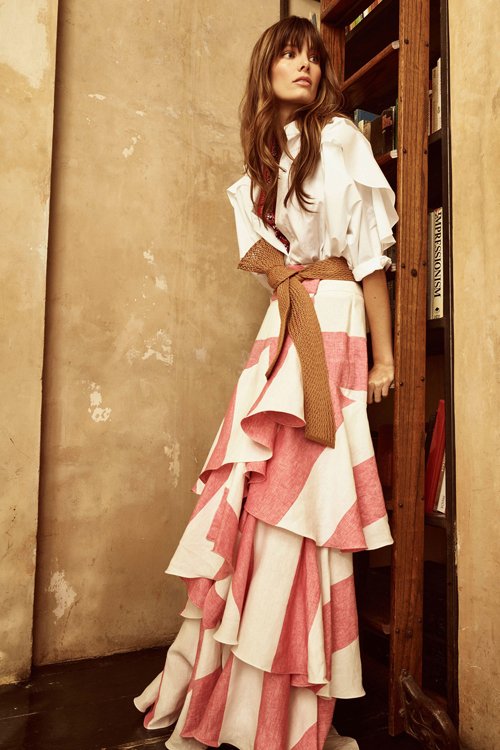 I really love this striped, tiered skirt (above) as well, but no surprise there as I am always drawn to stripes, even more than gingham. These voluminous sleeves, and maxi and midi lengths are evocative of the 1930s as well, although I would style them quite differently, beginning by doing away with the messy long hair! (I don’t know how people can wear long hair in summer particularly.)
I really love this striped, tiered skirt (above) as well, but no surprise there as I am always drawn to stripes, even more than gingham. These voluminous sleeves, and maxi and midi lengths are evocative of the 1930s as well, although I would style them quite differently, beginning by doing away with the messy long hair! (I don’t know how people can wear long hair in summer particularly.)
Unfortunately, even at half off as the tiered skirt is at the moment, $1250 is beyond my fashion budget. I can only dream.
Images from Vogue.com – click to view the full collection.

Winter Favourites
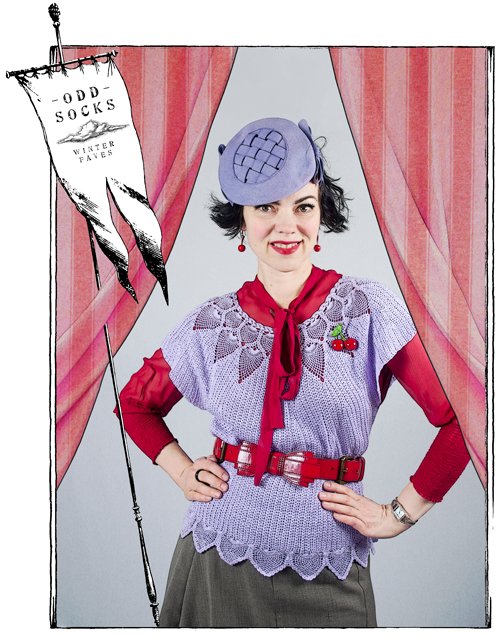 Last month I raced to photograph all my winter outfits before I did the biannual seasonal clothes storage swap-over, and spent about four days over two sessions to get through everything. This meant I had a compressed overview of which items were my popular over autumn/winter.
Last month I raced to photograph all my winter outfits before I did the biannual seasonal clothes storage swap-over, and spent about four days over two sessions to get through everything. This meant I had a compressed overview of which items were my popular over autumn/winter.
While it was interesting in hindsight, I was also a bit annoyed with myself for ‘overwearing’ some things considering how many other items in the same categories went unworn, or worn little, especially my hats. I have so many hats I don’t have time to wear them all even if I did wear a different one every day!
But, for what it’s worth, here are the favoured ones.
3 x
Three times wearing this vintage 40s purple hat (above) doesn’t sound like too many for all of autumn/winter, but this was all within a few weeks, and I simply own too many hats for this not to seem like I am squandering opportunities to make use of my marvellous collection.

5 x
This blue ribbed wool cardigan by Australian label is a vintage 1970s piece, and has been a favourite for many years since I found it in a thrift store in Berwick when I went op shopping with my sister, who lives out there. I just love the colour, which is what stood out: one of the gems amongst rack upon rack jammed with dross.
5 x
One of my favourite vintage brooches is this soaring seabird (above); I think it is probably celluloid. Admittedly, I have more than once worn it simply because I have left it on this cardigan – but that just speeds up the process of getting dressed in the morning!

7 x
These black leather Mary-Jane heels with the little bow on the strap are so comfortable and easy to walk in, it’s no wonder I reached for them so many times. On the days I wear higher heels, I walk to work in a flat pair of shoes, which is an extra thing to carry. If I don’t have to, that’s a bonus.

7 x
Simply an outright favourite, I reached for this double enamel cherry brooch many times this winter. Considering how many brooches I own, this is remarkable, but these cherries look good enough to eat. Plus, I must confess, while rhinestones catch my eye in the thrift store, I end up wearing them very little. I have always preferred opaque stones over sparkle – pearls, lapis lazuli, turquoise – and the same goes for costume jewellery. Enamel, Bakelite and wood win hands down over the multitude of rhinestone brooches I own.
And … drumroll … the winners!
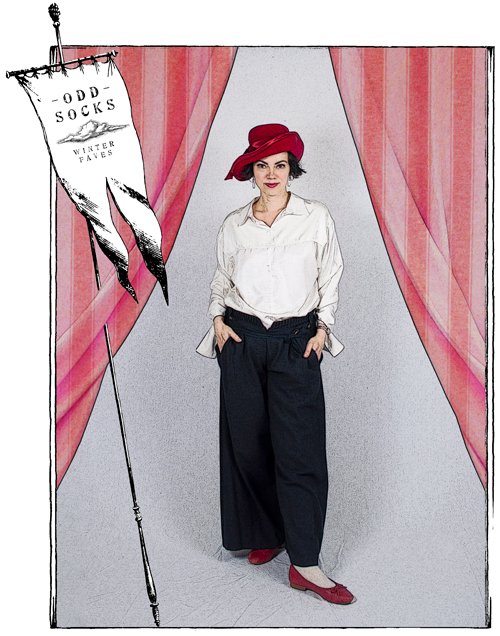
8 x
The cherry earrings (photo before the above) just pipped the cherry brooch at the post, beating it by only one wear. I usually wear them together, but once I wore the earrings with a glass fruit necklace. I always love a cherry motif, but these earrings are also so bright and cheerful, and seem to go with so many things.
8 x
The black pants by Ming (above and below) were worn eight times. I was rather disgusted by that total, as I do own other winter trousers, some of which only were worn once. But these are elasticised at the back, and the sheer wideness and soft wool flannel and suiting combination make them very comfortable and relaxed to wear. I have had them so many years, and had to do more than one repair, but they have proved their worth countless times, they deserve a prize!

Most of these favoured items were found in thrift stores (except for the two brooches and the hat which were bought from vintage boutiques). In fact, except for the red hat, every other item I am wearing in these pictures was also found in a thrift store, so I consider that a pretty good testament to a trained eye, able to spot a good purchase in the jumble of op shops!
Photos: August, September 2019
What is — and what is not — a fedora
THE DEFINITIVE GUIDE TO WHAT HAT IS THAT
 If you have been reading this blog for a little while, you will know that I love hats. While I am not a trained milliner, I do own a lot of hats (over 300) and books about hats, which I sometimes even read (as opposed to drooling over the pictures). I scour the internet for strange and wonderful hats, and for a long time I have been looking for the perfect 1930s or 1940s fedora. I already own one (pictured above), which I love for its film noir aspect, but I would love one more that has a more exaggerated shape, specifically in a colour I love (not black or brown, which are more ubiquitous).
If you have been reading this blog for a little while, you will know that I love hats. While I am not a trained milliner, I do own a lot of hats (over 300) and books about hats, which I sometimes even read (as opposed to drooling over the pictures). I scour the internet for strange and wonderful hats, and for a long time I have been looking for the perfect 1930s or 1940s fedora. I already own one (pictured above), which I love for its film noir aspect, but I would love one more that has a more exaggerated shape, specifically in a colour I love (not black or brown, which are more ubiquitous).
What I am finding however, is that vintage sellers seem to apply the word ‘fedora’ to any vaguely mannish hat, and I’m not sure if that’s because some of them aren’t really clear on the proper definition of a fedora, or because it is an extremely popular search term – I’ve seen it applied as a keyword for a frothy pink, flower-bedecked garden party hat! Today, however, I am going to clear up any misconceptions about what is – and what is not – a fedora, with a few key, easy-to-remember points to identify these same, same but different hats.
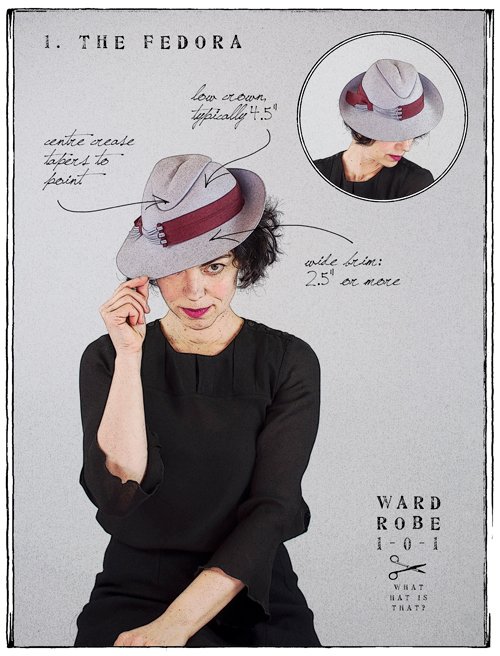 The Fedora
The Fedora
The fedora takes its name from an 1891 stage play, about a cross-dressing Princess Fedora who wears a centre-creased, soft wide-brimmed hat. Traditionally the crease is pinched at the front, forming a point or teardrop shape, but the crease can include diamond shaped crowns, and the positioning of dents can vary. Many other hats have centre dents, but the fedora combines this with a low crown – 4.5” or 11cm – and a wider brim of at least 2.5” or 6.4cm but they can be much wider, particularly in exaggerated fashion versions. The brims can be left raw, or stitched, or finished with ribbon-trim. This is the hat worn by Humphrey Bogart in the film Casablanca.
Key Points
- Low crown
- Centre crease pinched at front
- Wide brim
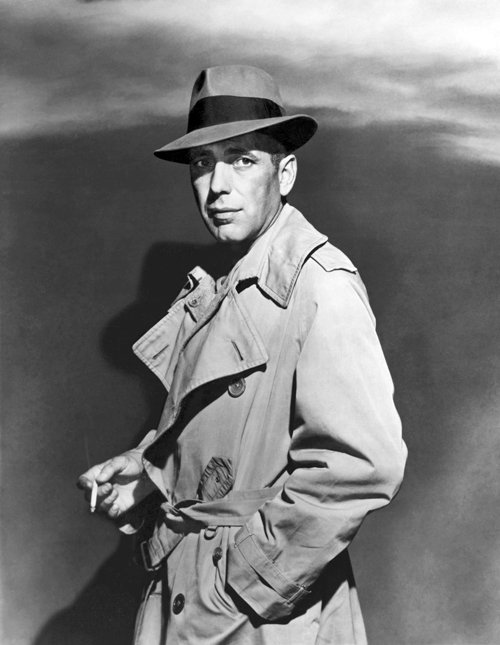 Humphrey Bogart in Casablanca; image found on Pinterest
Humphrey Bogart in Casablanca; image found on Pinterest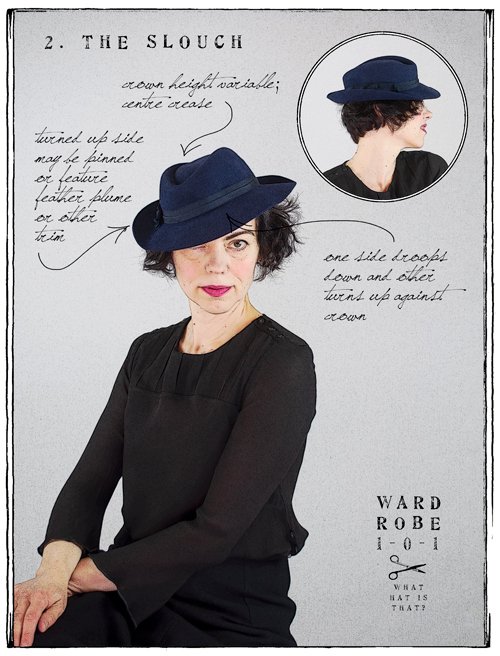
The Slouch
The next hat most commonly confused with a fedora, as far as I can discern, is the slouch hat. This is a style of hat traditionally worn by Australian soldiers (and those of many other nations), and is distinguished mainly with one side of the brim being turned up towards the crown, and one dipped down. The military hat has a fairly low crown, and the turned-up side is usually pinned to allow a rifle to be slung over the shoulder. Fashion versions vary in crown heights, but both feature a centre crease. Where the military hat is pinned up, the fashion hat may simply be decorated with trim on one side.
Key Points
- One side turned up, one side dipped down
- Crown height and brim width variable
- In place of the military pin, fashionable trim
 Australian soldier wearing a slouch in 1916; image found on Pinterest
Australian soldier wearing a slouch in 1916; image found on Pinterest
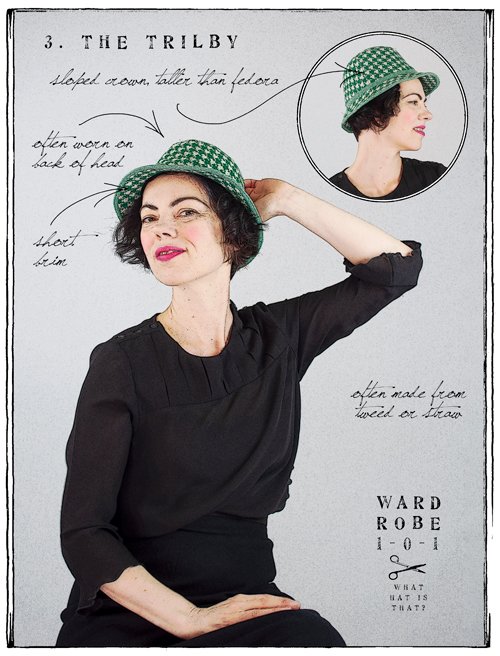 The Trilby
The Trilby
Another ubiquitous hat which can also be confused for a fedora is the trilby. Surprisingly, this is another hat whose inception lies in a stage play around the same time! George du Maurier’s 1894 novel Trilby was translated to the stage in London, and a hat of this shape was worn. Though the hat was worn by a woman, it became popular for men shortly after. It’s often made of tweed, like mine, or in straw for summer, though more properly its short brim is snapped up at the back. It has a much taller crown than a fedora, with sloped sides, and a popular hat with musicians, it is often worn on the back of the head. Sean Connery is well-known for wearing a trilby.
Key Points
- Short brim, usually snapped up at back
- Taller crown with sloping sides
- Designed to be worn further back on the head
 Sean Connery wearing a trilby; image found on Pinterest
Sean Connery wearing a trilby; image found on Pinterest
 The Homburg
The Homburg
The homburg is quite a masculine hat that has not really been translated into women’s versions, but this turquoise felt hat I own does not really fall into any other style, so I am using it to illustrate this style, perhaps most famously worn by Winston Churchill. Its most distinctive feature is the pencil-curled brim (which mine does not have at all). The hat is usually made of hard felt, with straight sides and a pronounced and quite wide centre crease. It is still a very popular hat shape for men today – and gangsters of all eras! Michael Corleone of The Godfather, and Nucky Thompson of Boardwalk Empire both present fine examples of the homburg’s sinister aspect.
Key Points
- Short, curled brim
- Taller crown with straight sides
- Wide, shallow centre crease
 Winston Churchill was famous for his homburg; image found on Pinterest
Winston Churchill was famous for his homburg; image found on Pinterest
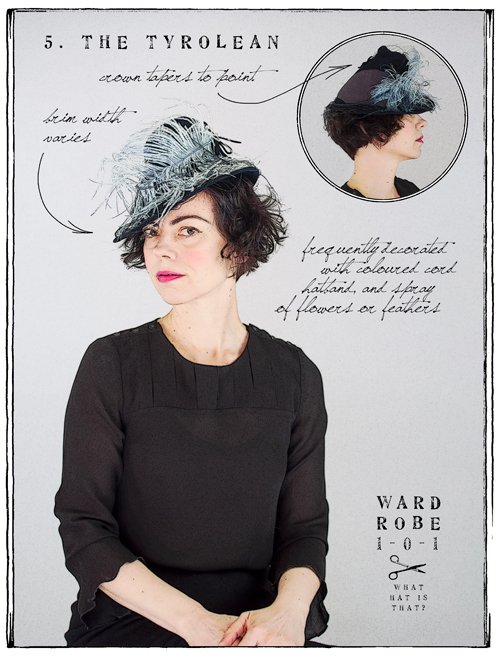
The Tyrolean
The Tyrolean hat style is one of my favourite jaunty styles! It originates from the Tyrol in the Alps, in what is now variously Austria, Germany, Italy and Switzerland. Its most distinctive feature is the crown that rises to form a point. The brim traditionally was roughly the width of a hand, and the hat was usually decorated with hatband made of coloured cord and a spray of flowers, feathers or brush. However, brims and crown heights varied in different parts of the Tyrol. Also known as a Bavarian or Alpine hat, it was originally made from green felt. Fortunately, fashion versions are not so limited in scope. Mine is navy, trimmed in a wide grosgrain band, netting, and a light blue ostrich feather. Edward VIII stayed in Austria after his abdication and often wore the hat, popularising its style.
Key Points
- Crown tapers to a point
- Crown height and brim width varies
- Decorated with flowers or feathers
 Edward VIII made the Tyrolean hat famous after his abdication
Edward VIII made the Tyrolean hat famous after his abdication
In Conclusion
Of course, it must be remembered that these key points are only guidelines for identifying a general style – they are not hard and fast rules. Fashion hats often take inspiration from traditional styles and designers will add their own twist, pushing and pulling them in exaggerated directions, creating hybrids with brilliant details and wonderful new ideas. A hat should be the exclamation point of an outfit, the finishing touch to delight the eye – much more than a conservative tradition. But it’s always good to know the rules before you break them.
Photos: September 2019
The Tie Cuff
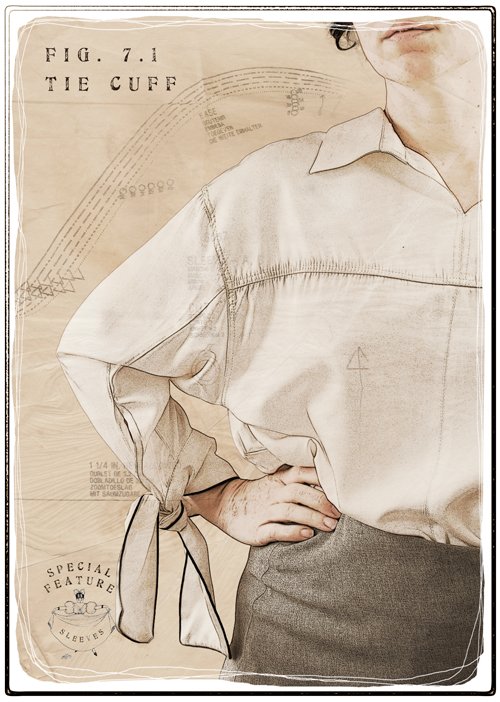
Long cuffs that fasten with a knot or bow, or ‘tie cuffs’ as I have dubbed them, add a decorative element to what may be an otherwise ordinary sleeve. But if you have never sported a tie cuff, be warned: unsuspected dangers lurk in these knotty waters!
The dropped shoulder of this long sleeve belongs to a rather dramatic, billowy blouse that features very large and long tie cuffs. The first time I wore this blouse I immediately knew why I had found it at the thrift store. While the fabric is soft, it is quite substantial, and the cuff takes the form of long, wide ties, accentuated by black piping, that are knotted at the wrist. As the sleeves are quite wide too, I took care to knot them so that the ties fell on the outside of the hand.
The ties were disconcerting at first, a hindrance until I allowed gravity to drag at the weight of the knots to keep them out my way while using my computer keyboard at work. I also discovered another hazard at lunchtime: because of the heavy, floppy ties, I managed to splash a bit of my curry laksa soup on the cuff (fortunately I was able to wash it out). This blouse is clearly for those who thumb their nose at sartorial danger, and it was admired by my work colleagues.

… if you have never sported a tie cuff, be warned: unsuspected dangers lurk in these knotty waters!
Three-quarter sleeves, such as on this striped blouse with its set-in sleeves, are a more sensible design choice combined with dangling tie cuffs. This cotton fabric (adorably striped like traditional ticking, which I love) is much lighter as well, so the ties pose no danger.
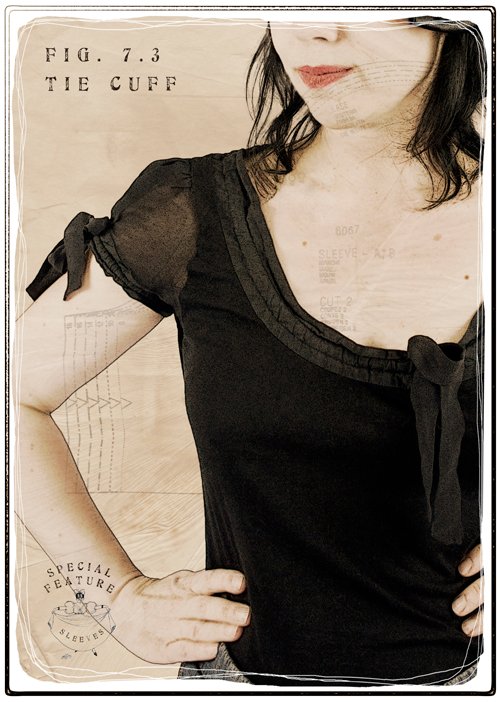
The puff sleeves, also set-in, of this cotton modal and silk tee have silk chiffon ties – lighter still – which are long and thin enough to tie into bows: both decorative and too short to interact perilously with the environment. An asymmetrically-placed bow at the neckline combined with the two sleeve bows create a pretty and overtly feminine top.
Three styles of tie-cuffs, three very different effects with various danger levels: from big drama, to breezy and casual, to whimsical femininity.
Review all the sleeves in the gallery thus far.
Roll-Up, Roll-Up!
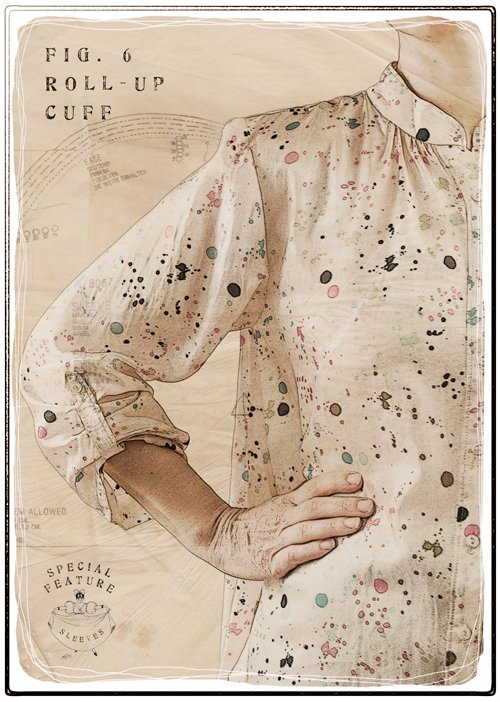 Another type of cuffed sleeve is the classic roll-up. A tab on the inside of a long sleeve attaches to a button on the exterior when the sleeve is rolled up. Depending on the stiffness of the fabric, one can neatly fold it (literally roll it up) or simply gather it and allow it to fall in natural folds as I have done in this example.
Another type of cuffed sleeve is the classic roll-up. A tab on the inside of a long sleeve attaches to a button on the exterior when the sleeve is rolled up. Depending on the stiffness of the fabric, one can neatly fold it (literally roll it up) or simply gather it and allow it to fall in natural folds as I have done in this example.
This cuff should not be confused with the dressy cuff often seen on more formal sleeves and pant legs (both shorts and full-length trousers). Unlike the roll-up, which reveals the seam, this cuff is decorative, created from a separate piece of fabric and attached with the front side of the fabric facing outwards.
The roll-up is a casual sleeve, but also quite practical when you need to get your hands dirty. My silk smock blouse takes that concept to the nth degree with a paint splatter print!
Review all the sleeves in the gallery thus far.


